Adventures in Diagrammatic Reasoning—A Few Notes
From the Series: Graphic Ethnography on the Rise
From the Series: Graphic Ethnography on the Rise

The evidence of a (re)turn to images in the academy is everywhere. One can pull one's hand through the air of current reference and quickly hold numerous texts pointing to the importance of visual semiotics to social analysis and political critique—W. J. T. Mitchell’s work to develop a critical visual cultural image science, Constantine V. Nakassis’s writings on image ontology, Peter Galison and Carrie Jones’s development of an image science provide a somewhat arbitrary handful of references (see Barthes 1977; Mitchell 1987; Nakassis 2020; Galison 1997; see also Nakassis and Barker 2020). Some works build on earlier work in visual reason, image interpretation, diagrammatic desire, resurrecting, for instance, Roland Barthes’s attempts to understand the semiotic mediation of political reason from an iconic point of view; or, Lacan’s concept of the image unpinning the imaginary. When speaking of Lacan, some authors sometimes provide a nod to Franz Fanon, less often to legacies of white and black feminist analysis of the gaze—for instance, the works of Laura Mulvey and bell hooks (see Mulvey 1975; hooks 1992). Of course, linguistic anthropologists have long toggled between emphasizing the role that the metaindexicality of iconicity and the role that the iconicity of metaindexicality plays in the total linguistic fact of language in society. We can think here of Michael Silverstein’s approach to metricalization—the “patterned chunking of discourse” in which denotational texts come to be experienced as having a comparable form (genre, enregistration [Agha 2005]). Or we might think of Susan Gal and Judith Irvine's recent work, Signs of Difference (2019), which has footprints back to Linda Waugh’s proposal that language is grounded in phonological iconicity (Waugh 1992). Alongside all of these discussions, to a more or less degree, is an interest in how images, icons, and diagrams as a type of iconicity open different possibilities for our conceptual understanding of political mediation (see Deleuze and Guattari 1996; Morreti 2007).
Or we can forget about all these semiotic theories and simply celebrate the renaissance of image ethnography—the surge in film and drawing ethnographies and the increasingly legitimized nature of this semiotic form of sociocultural re-presentation, which includes diverse examples and styles of graphic-ethnographic practice.
The following doesn’t pretend to intervene in these debates in any direct way. Rather I will simply walk through some examples of how a particular relation to image-making, diagrammatic reasoning, has been publicly apparent in my work since The Cunning of Recognition (2002). In doing so, I suggest how what may appear to be more or less dramatic shifts in my use of images are mere surface effects masking my longstanding interest in how Peircean diagrammatic reason simultaneously evokes and disturbs the diagrammaticity of social existence—thus how diagrammatic reasoning refers back to an inward acquaintance with the semiotic scaffolding of region of existence that literally gives it and us shape. Peirce gave succinct definitions of the diagram, such as, “a representamen which is predominantly an icon of relations and is aided to be so by conventions. Indices are also more or less used. It should be carried out upon a perfectly consistent system of representation, one founded upon a simple and easily intelligible basic idea” (Peirce 1903). He also probed the experiential logics of rationality when in the vicinity of diagrams. While Peirce understood the diagram to be an “Icon of a set of rationally related objects,” what he meant by “rationally related” was that “there is between them, not merely one of those relations which we know by experience, but know not how to comprehend, bit one of those relations which anyone who reasons much all must have an inward acquaintance with” (Stjernfeld 2000). We having a feeling for the inner diagram—the trotte-bébé—that is the body each of us introjected already shaped by the pleasures and disciplines of racial and gendered schematics, as well as countless other modes of corporeal distribution.[1]
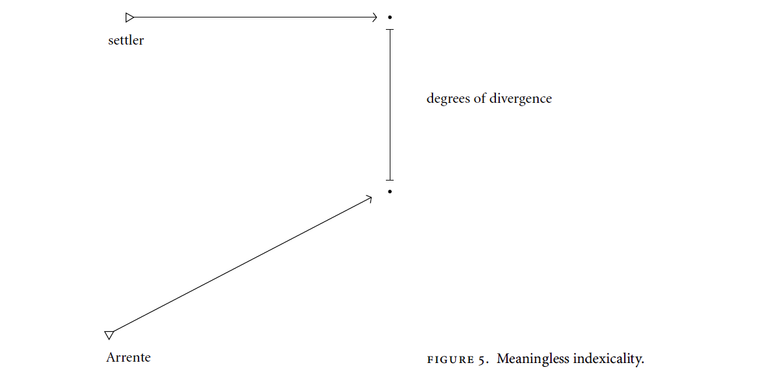
In “The Vulva Thieves,” I sought to diagrammatically represent the function of force in the field of foundational ethnography. More specifically the diagrams represent the directionality of force in translational logics as Central Desert Indigenous men sought to lengthen the stay of Spencer and Gillen and thus postpone the return of vicious settler expansion. The three diagrams here attempt to suggest worlds in process (the cubes of Figs. 6 & 7 as compared to the unidimensionality of Fig. 5). The cubes' differential orientation to space push against some shared ontology. And the “degree of detachment” indicating how colonial force drives, under extreme conditions, the colonized world to have to do the work of translational orientation to a colonizer world. If I were to redo these diagrams, I might put more weight on the back effects on the worlds themselves, perhaps through the dialectic of sense and nonsense Deleuze discussed in The Logic of Sense (1969).
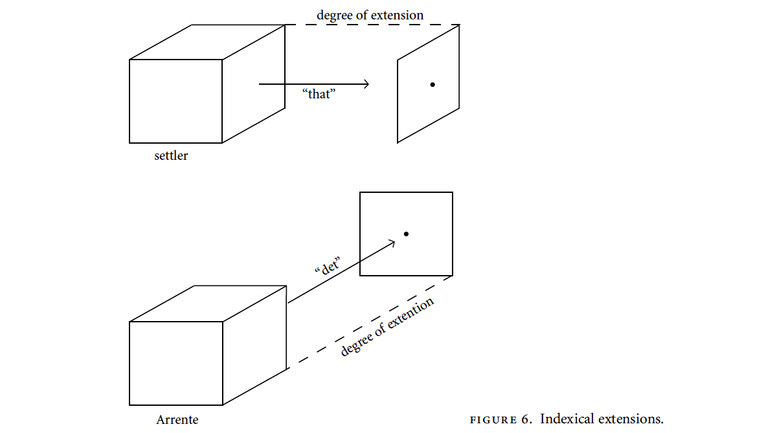
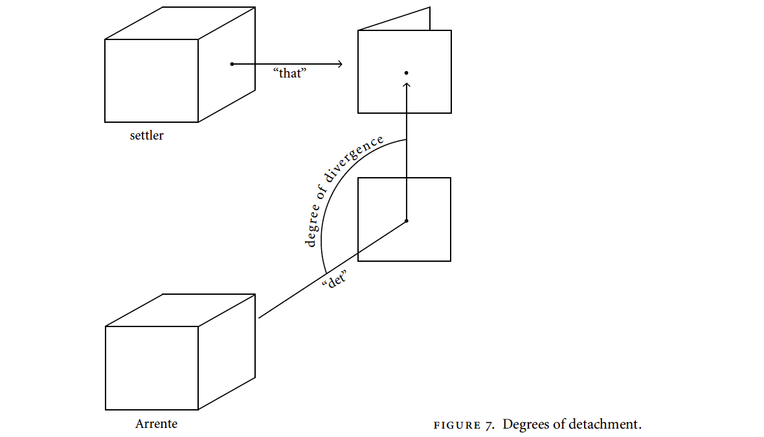
I consider the cover design of Geontologies (2018a) to be a form of diagrammatic reason with figural features. It was originally composed for a 2014 publication as part of the “the Anthropocene Project” at Haus der Kulturen der Welt, Berlin. Laminating a heroin-fueled mammalian cardiovascular system onto plate tectonics the image originally meant to evoke a diagrammatic rationality whereby viewers feel the truth of societal addiction to carbon fuel and its subtending carbon imaginary.

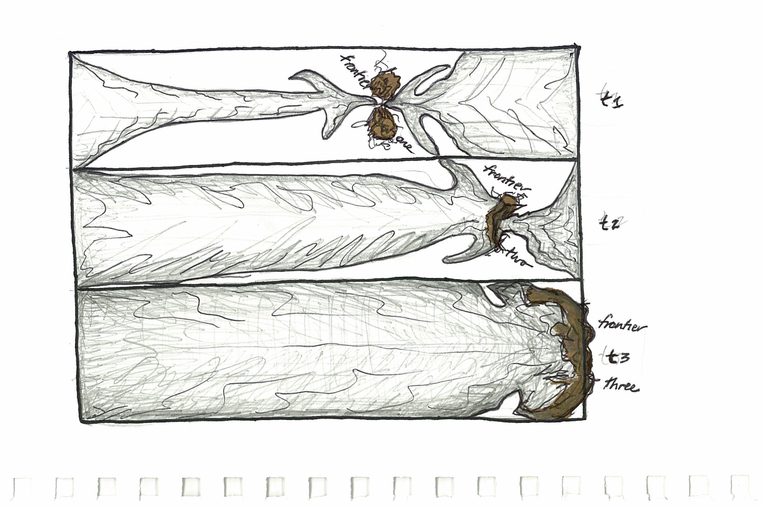
Originally drawn for Vivian Ziherl’s edited issue of e-flux journal, Trade Markings (Povinelli 2018b). These three figures present three different images of ideologies of the frontier and horizon as viewed from models of sovereign, rhizomatic, and sedimentational power. For me, these images are diagrams take the diagrammatic reason of the figures in Cunning of Recognition (2002) and then filter them through the theoretical frames of Carl Schmitt, Gilles Deleuze and Felix Guattari, and Eduard Glissant. These images also anticipate my discussion of the four axioms of existence in Between Gaia and Ground (2021b), specifically my call to turn from ontological entanglement to sedimentational history as read from the ancestral catastrophe of settler colonialism and the Black Atlantic.
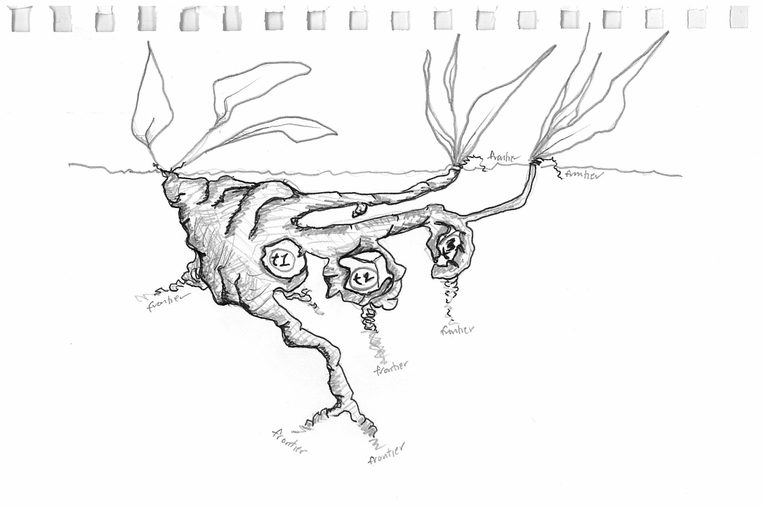


In an interview with Nick Earhart, I noted that I intentionally avoided the strip-logic of comic book style graphic memories and novels. I wanted to push away from the syntactic logic of the comic strip and instead create as many stand-alone images as possible, each evoking a dense soundless landscape such that “the relations which we know by experience, but know not how to comprehend.” In short even as the figural element comes to the foreground, a critical diagrammatic reason subtends their organization. I think this is equally clear in the film version and subsequent drawings that recombine previous elements—I include an example of each immediately after the following five pages from the The Inheritance (2021a).

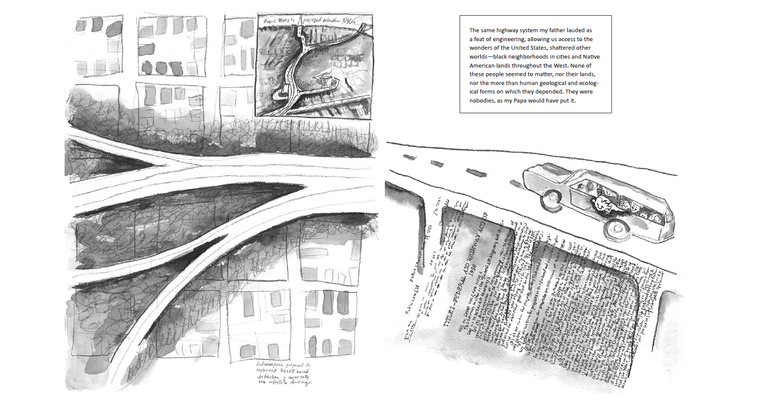
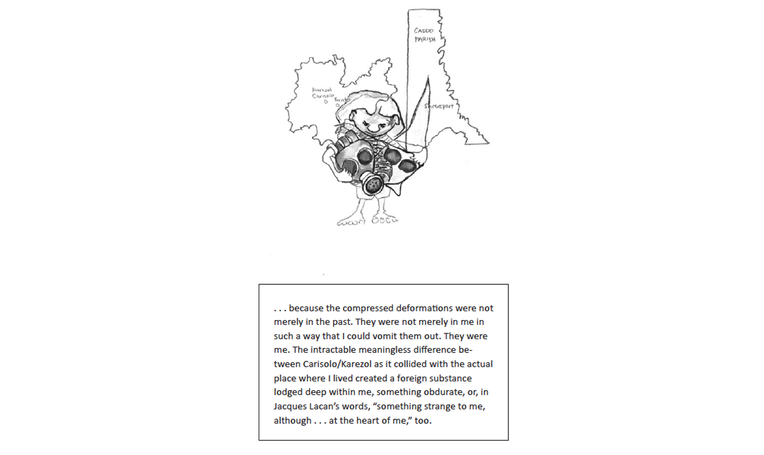
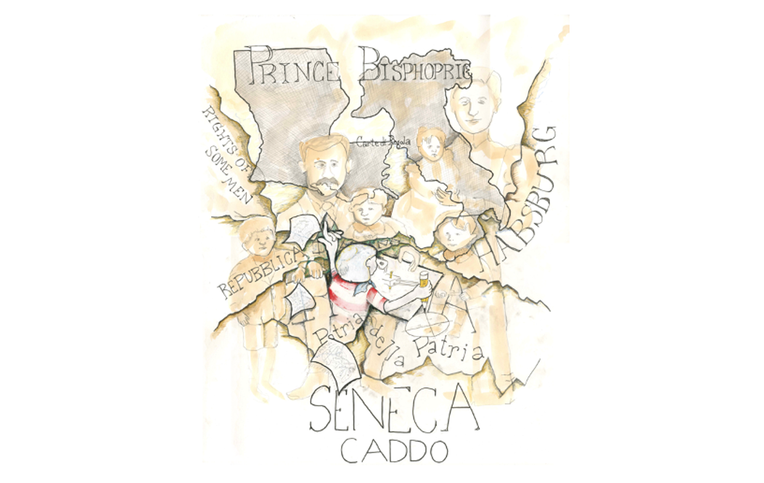

Some might argue that these latter figural diagrams allow the authorial subject to emerge as an inflection point of self-reflection. After all, one can locate little Elizabeth's movements across the scenes of dispossession and racialization. But each image, as well as the opening and concluding graph, warns readers against such facile interpretations. The opening glyph, for instance, notes that the memoir is full of the distortions of compressed and fractured histories. And most of the images attempt to conjure the (de)formative force of social diagrammatic logics. All the characters ultimately are no more real than the figure-boxes of The Cunning of Recognition (2002) coming into form and substance under the sedimentational histories of the e-flux third image. To paraphrase Donald Winnicott, you cannot not ask little Elizabeth whether she is real or pretend, because she is the result of their difference.
[1] “trotte-bébé is from “The Mirror Stage as Formative of the I Function” (Lacan 1966: 76). But this inner “walker” is composed of how the Other looks across the field of racialization, gender, class, etc. There is no “gaze” and then the I-function which rotates out the deictics of nominal hierarchies. There is the gaze that stares, shrieks, redraws, smiles. There are the multiple compounding corporeal reactions to these varieties of affective/linguistic inflections—pulling away from a parent or friend, a primary disavowal that such could be “me”; a warm glow of becoming the object of embrace. One does not, in other words, have to enter the symbolic to be organized by its logics.
Agha, Asif. 2005. “Voice, Footing and Enregisterment.” Linguistic Anthropology 15, no. 1: 38–59.
Barthes, Roland. 1977. “The Rhetoric of the Image,” In Image-Music-Text, translated by Stephen Heath, 35–51. New York: Hill & Wang.
Deleuze, Gilles. 1969. The Logic of Sense. Translated by Mark Lester. New York: Columbia University Press.
Deleuze, Gilles, and Felix Guattari. 1996. What is Philosophy? Translated by Hugh Tomlinson and Graham Burchell. New York: Columbia University Press.
Gal, Susan, and Judith T. Irvine. 2019. Signs of Difference. Cambridge: Cambridge University Press.
Galison, Peter. 1997. Image and Logic. Chicago: University of Chicago Press.
hooks, bell. 1992. “The Oppositional Gaze.” In Black Looks: Race and Representation, 115-131. Boston: South End Press.
Lacan, Jacques. 1996. Écrits. Translated by Bruce Fink. New York: W. W. Norton.
Mitchell, W. J. T. 1987. Iconology: Image, Text, Ideology. Chicago: University of Chicago Press.
Morreti, Franco. 2007. Graphs, Maps, Trees: Abstract Models for a Literary History. Translated by Alberto Piazza. London: Verso.
Mulvey, Laura. 1975. “Visual Pleasure and Narrative Cinema.” Screen 16, no. 3: 6–18.
Nakassis, Constantine V. 2020. “The Hero’s Mass and the Ontological Politics of the Image.” Journal of Cinema and Media Studies 60, no. 1: 70–91.
Nakassis, Constantine V., and Maghanne Barker. 2020. “Images.” Special Issue. Semiotic Review 9.
Peirce, Charles S. 1903. Logical Tracts. No. 2. On Existential Graphs, Euler’s Diagrams, and Logical Algebra. MS [R] 492.
Povinelli, Elizabeth A. 2002. The Cunning of Recognition: Indigenous Alterities and the Making of Australian Multiculturalism. Durham, N.C.: Duke University Press.
Povinelli, Elizabeth A. 2018a. Geontologies: A Requiem to Late Liberalism. Durham, N.C.: Duke University Press.
Povinelli, Elizabeth A. 2018b. “Horizons and Frontiers—Late Liberalism, Territoriality, and Toxic Habitats.” In "Trade Markings," edited by Vivian Ziherl. Special issue, e-flux journal 90.
Povinelli, Elizabeth A. 2021a. The Inheritance. Durham, N.C.: Duke University Press.
Povinelli, Elizabeth A. 2021b. Between Gaia and Ground: Four Axioms of Existence and the Ancestral Catastrophe of Late Liberalism. Durham, N.C.: Duke University Press.
Povinelli, Elizabeth A., and Thomas Bartlett. 2021. The Inheritance.
Stjernfelt, Frederik. 2000. “Diagrams as Centerpiece of a Peircean Epistemology.” Transactions of the Charles S. Peirce Society 36, no. 3: 367–384.
Waugh, Linda. 1992. “Let’s Take the Con out of Iconicity.” American Journal of Semiotics 9, no. 1: 7–47.